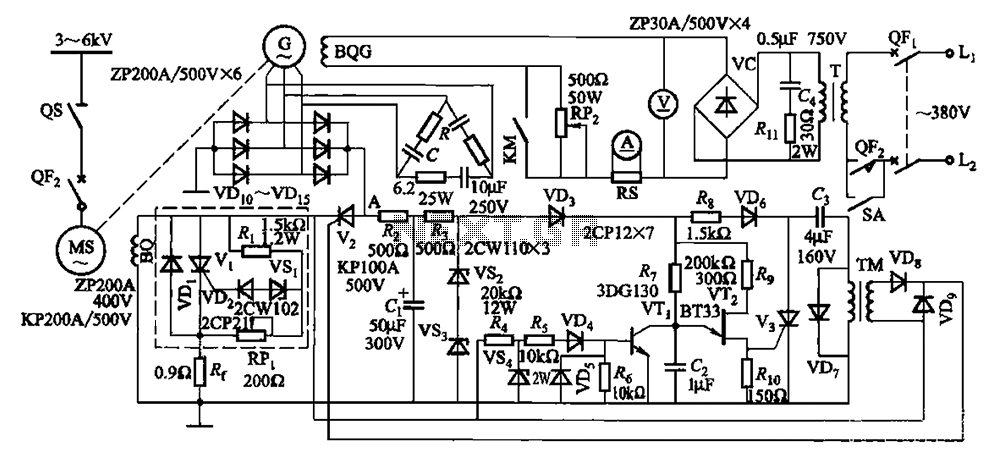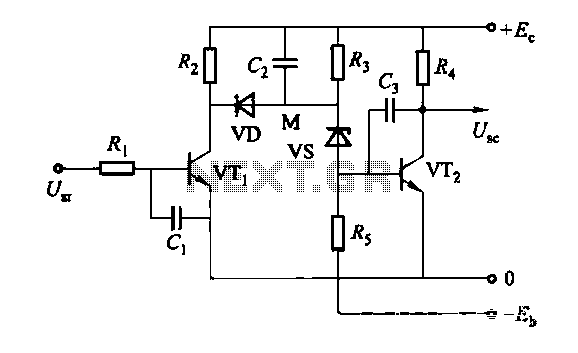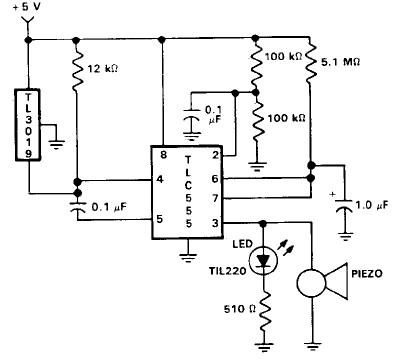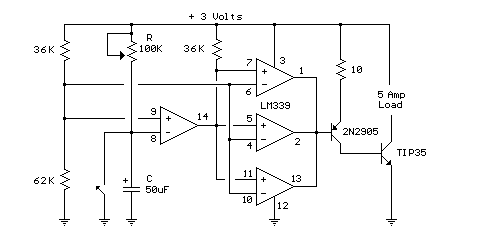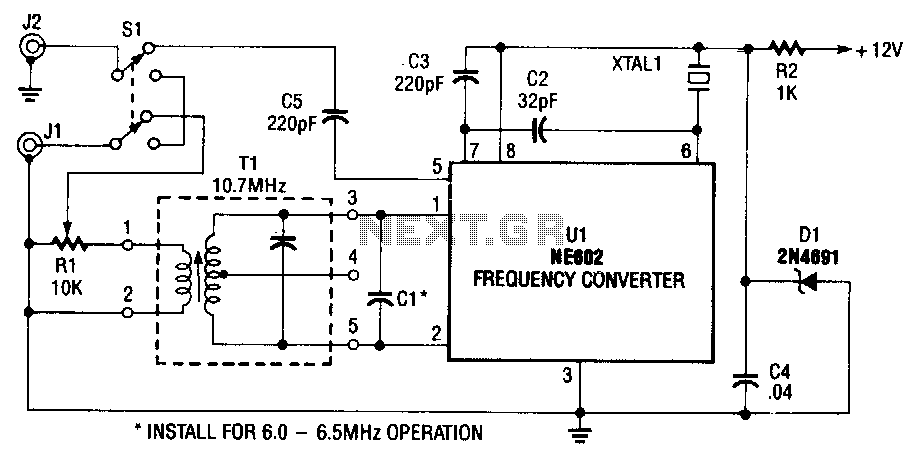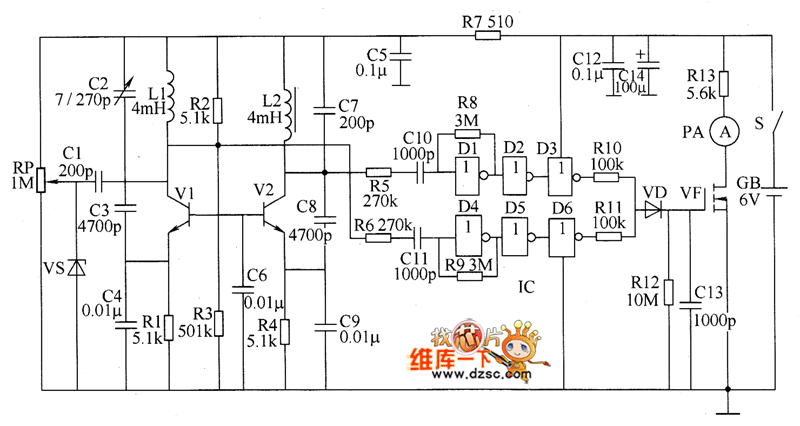
short circuit protection for balanced
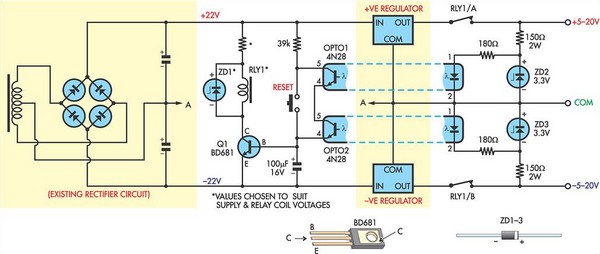
This circuit was designed to protect a dual rail power supply from shorts across the two rails. It uses an optocoupler to monitor each supply rail, with the internal LEDs powered from ZD2 and ZD3 and the associated resistors. While the LEDs are on, the optocouplers' internal transistors are both turned on, which ensures that transistor Q1 is on and relay RLY1 is energized. If either rail is short-circuited, the associated optocoupler is turned off, depriving Q1 of base current, and the relay then drops out to disconnect the supply rails. Operation is restored by pressing the reset button. The value of ZD1 and the associated resistor should be chosen to suit the supply and relay coil voltages.
The circuit design incorporates a dual rail power supply protection mechanism utilizing optocouplers for voltage monitoring. The optocouplers are configured such that their internal light-emitting diodes (LEDs) are powered by Zener diodes ZD2 and ZD3, which stabilize the voltage across the LEDs and ensure consistent operation. The associated resistors are selected to limit the current through the LEDs to safe levels, thus preventing damage to the components.
In normal operation, when the supply rails are functioning correctly, the LEDs in the optocouplers illuminate, activating the internal phototransistors. This activation allows current to flow through transistor Q1, which in turn energizes relay RLY1. The energized relay maintains the connection between the power supply rails, allowing the system to operate normally.
In the event of a short circuit across either rail, the corresponding optocoupler's LED will turn off, resulting in the deactivation of its internal phototransistor. This deactivation removes the base current from transistor Q1, causing it to turn off. Consequently, relay RLY1 is de-energized, breaking the connection between the supply rails and protecting the circuit from potential damage due to overcurrent conditions.
To restore operation after a fault condition, a reset button is incorporated into the design. Pressing this button re-enables the circuit, allowing the optocouplers to function normally again, provided that the short circuit has been cleared.
The selection of ZD1 and its associated resistor is critical, as these components must be appropriately rated to handle the supply voltage and the relay coil voltage. This ensures that the circuit operates effectively under different load conditions while providing reliable protection to the power supply system.This circuit was designed to protect a dual rail power supply from shorts across the two rails. It uses an optocoupler to monitor each supply rail, with the internal LEDs powered from ZD2 and ZD3 and the associated resistors. While the LEDs are on, the optocouplers internal transistors are both turned on which ensures that transistor Q1 is on and
relay RLY1 is energised. If either rail is short-circuited, the associated optocoupler is turned off, robbing Q1 of base current and the relay then drops out to disconnect the supply rails. Operation is restored by pressing the reset button. The value of ZD1 and the associated resistor should be chosen to suit the supply and relay coil voltages.
🔗 External reference
The circuit design incorporates a dual rail power supply protection mechanism utilizing optocouplers for voltage monitoring. The optocouplers are configured such that their internal light-emitting diodes (LEDs) are powered by Zener diodes ZD2 and ZD3, which stabilize the voltage across the LEDs and ensure consistent operation. The associated resistors are selected to limit the current through the LEDs to safe levels, thus preventing damage to the components.
In normal operation, when the supply rails are functioning correctly, the LEDs in the optocouplers illuminate, activating the internal phototransistors. This activation allows current to flow through transistor Q1, which in turn energizes relay RLY1. The energized relay maintains the connection between the power supply rails, allowing the system to operate normally.
In the event of a short circuit across either rail, the corresponding optocoupler's LED will turn off, resulting in the deactivation of its internal phototransistor. This deactivation removes the base current from transistor Q1, causing it to turn off. Consequently, relay RLY1 is de-energized, breaking the connection between the supply rails and protecting the circuit from potential damage due to overcurrent conditions.
To restore operation after a fault condition, a reset button is incorporated into the design. Pressing this button re-enables the circuit, allowing the optocouplers to function normally again, provided that the short circuit has been cleared.
The selection of ZD1 and its associated resistor is critical, as these components must be appropriately rated to handle the supply voltage and the relay coil voltage. This ensures that the circuit operates effectively under different load conditions while providing reliable protection to the power supply system.This circuit was designed to protect a dual rail power supply from shorts across the two rails. It uses an optocoupler to monitor each supply rail, with the internal LEDs powered from ZD2 and ZD3 and the associated resistors. While the LEDs are on, the optocouplers internal transistors are both turned on which ensures that transistor Q1 is on and
relay RLY1 is energised. If either rail is short-circuited, the associated optocoupler is turned off, robbing Q1 of base current and the relay then drops out to disconnect the supply rails. Operation is restored by pressing the reset button. The value of ZD1 and the associated resistor should be chosen to suit the supply and relay coil voltages.
🔗 External reference
Warning: include(partials/cookie-banner.php): Failed to open stream: Permission denied in /var/www/html/nextgr/view-circuit.php on line 713
Warning: include(): Failed opening 'partials/cookie-banner.php' for inclusion (include_path='.:/usr/share/php') in /var/www/html/nextgr/view-circuit.php on line 713
